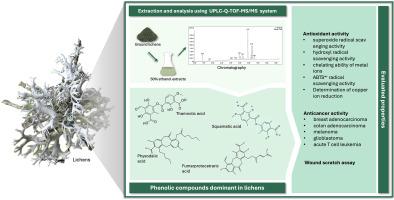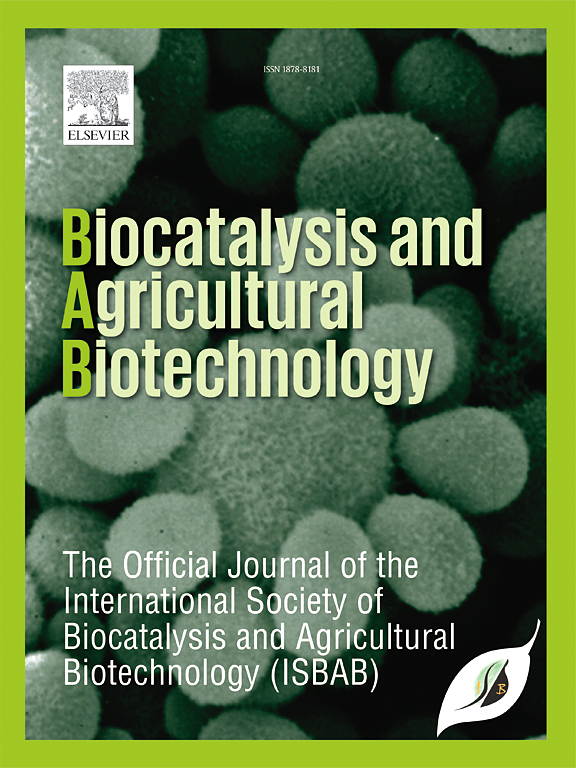The cytotoxic potential of polyphenols extracted from eight lichen species and their antioxidant activity against the cancer cell lines
IF 3.4
Q2 BIOTECHNOLOGY & APPLIED MICROBIOLOGY
引用次数: 0
Abstract
This article presents the results of in vitro experiments on the cytotoxic potential of ethanol extracts from 8 lichen species, Cetraria islandica, Cladonia arbuscula, C. digitata, C. gracilis, C. rangiferina, C. uncialis, Platismatia glauca and Pseudevernia furfuracea, against 5 human cancer cell lines - MCF-7, Caco-2, SK-mel-28, U87MG and Jurkat.
The potential of the re-dissolved and then tested extracts was determined by means of TPC, free radical scavenging activity in ABTS•+, superoxide and hydroxyl tests, copper ion reduction activity, and chelating ability of ferrous ion. The highest TPC (114.29 mg GAE/g), ABTS•+ (440.61 mmol TE/100 g) and hydroxyl (IC50: 0.71 mg/mL) radical scavenging activities tests was obtained for the Pseudevernia furfuracea extract, and for the superoxide radical scavenging activity test (IC50: 0.98 mg/mL), the highest potential was found for the extracts from P. furfuracea and Cladonia digitata, and for the copper ion reduction activity (88.15 mmol TE/100 g) and chelating ability of ferrous ion (IC50: 1.83 mg/mL) tests, the highest potential was shown for the extract from C. digitata. In the cytotoxicity tests, the strongest potential was shown by the P. furfuracea extract against the MCF-7 (IC50: 110.84 μg/mL), Caco-2 (IC50: 123.86 μg/mL) and U87MG (IC50: 107.43 μg/mL) cancer cell lines. A wound scratch test against the MCF-7 using Pseudevernia furfuracea extract showed a 50% reduction in tumor cell proliferation. The qualitative - 28 secondary metabolites from depside and depsidones classes - and quantitative profile of lichen extracts was analyzed by UPLC-Q-TOF-MS/MS.

从八种地衣中提取的多酚的细胞毒性潜力及其对癌细胞株的抗氧化活性
本文介绍了从 8 种地衣(Cetraria islandica、Cladonia arbuscula、C. digitata、C. gracilis、C. rangiferina、C. uncialis、Platismatia glauca 和 Pseudevernia furfuracea)中提取的乙醇提取物对 5 种人类癌细胞系(MCF-7、Caco-2、SK-mel-28、U87MG 和 Jurkat)的细胞毒性潜力的体外实验结果。通过 TPC、ABTS-+、超氧化物和羟基测试中的自由基清除活性、铜离子还原活性和亚铁离子螯合能力,测定了重新溶解后进行测试的提取物的潜力。在 TPC(114.29 毫克 GAE/克)、ABTS-+(440.61 毫摩尔 TE/100 克)和羟基(IC50:0.71 毫克/毫升)自由基清除活性测试中,糠假毛蕊花提取物的最高;在超氧自由基清除活性测试中(IC50:0.在铜离子还原活性(88.15 mmol TE/100 g)和亚铁离子螯合能力(IC50:1.83 mg/mL)测试中,C. digitata 提取物的潜力最大。在细胞毒性测试中,糠虾提取物对 MCF-7(IC50:110.84 μg/mL)、Caco-2(IC50:123.86 μg/mL)和 U87MG(IC50:107.43 μg/mL)癌细胞株的毒性最强。使用假 fevernia furfuracea 提取物对 MCF-7 进行的伤口划痕试验显示,肿瘤细胞的增殖减少了 50%。通过 UPLC-Q-TOF-MS/MS 分析了地衣提取物的定性(28 种去苷类和去苷酮类次生代谢物)和定量特征。
本文章由计算机程序翻译,如有差异,请以英文原文为准。
求助全文
约1分钟内获得全文
求助全文
来源期刊

Biocatalysis and agricultural biotechnology
Agricultural and Biological Sciences-Agronomy and Crop Science
CiteScore
7.70
自引率
2.50%
发文量
308
审稿时长
48 days
期刊介绍:
Biocatalysis and Agricultural Biotechnology is the official journal of the International Society of Biocatalysis and Agricultural Biotechnology (ISBAB). The journal publishes high quality articles especially in the science and technology of biocatalysis, bioprocesses, agricultural biotechnology, biomedical biotechnology, and, if appropriate, from other related areas of biotechnology. The journal will publish peer-reviewed basic and applied research papers, authoritative reviews, and feature articles. The scope of the journal encompasses the research, industrial, and commercial aspects of biotechnology, including the areas of: biocatalysis; bioprocesses; food and agriculture; genetic engineering; molecular biology; healthcare and pharmaceuticals; biofuels; genomics; nanotechnology; environment and biodiversity; and bioremediation.
 求助内容:
求助内容: 应助结果提醒方式:
应助结果提醒方式:


